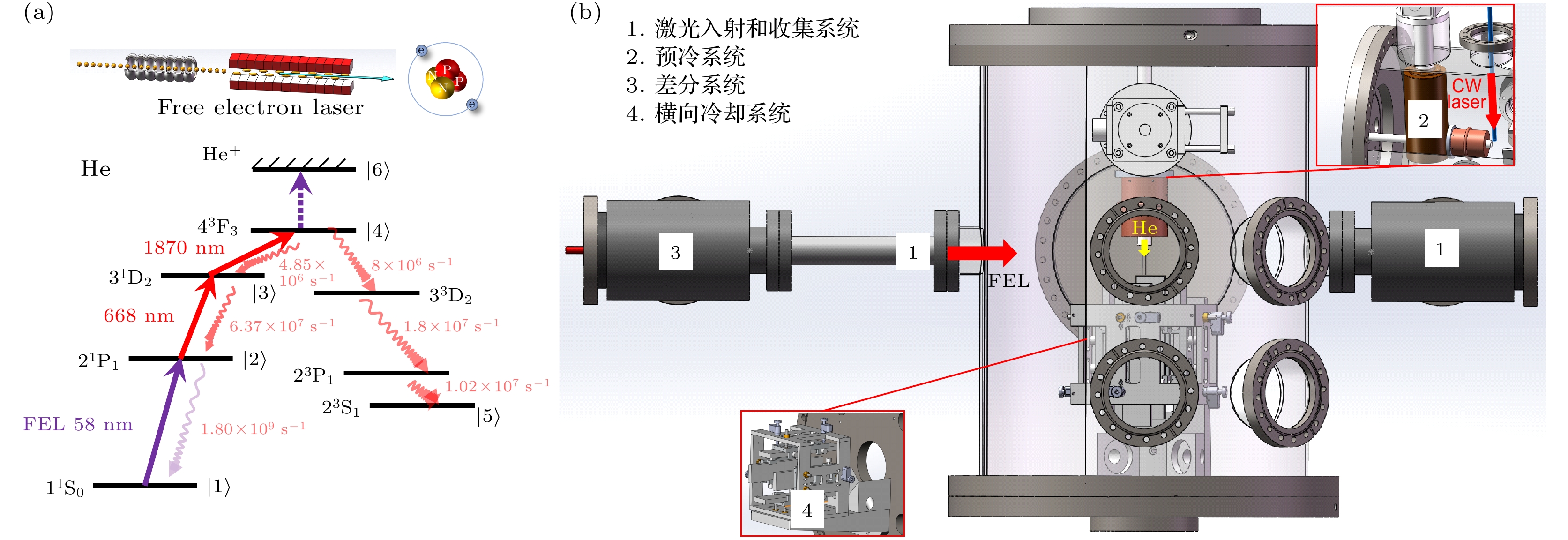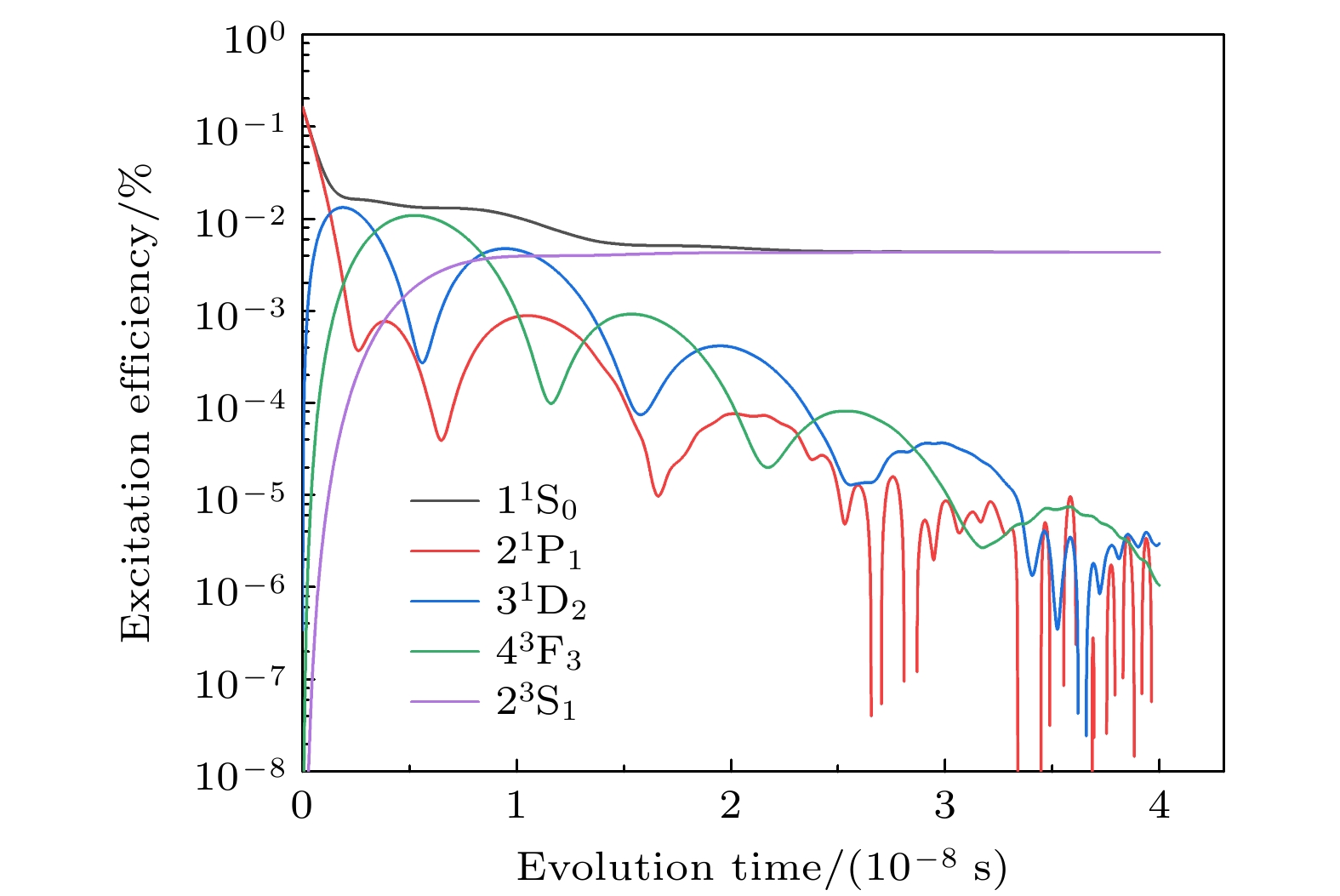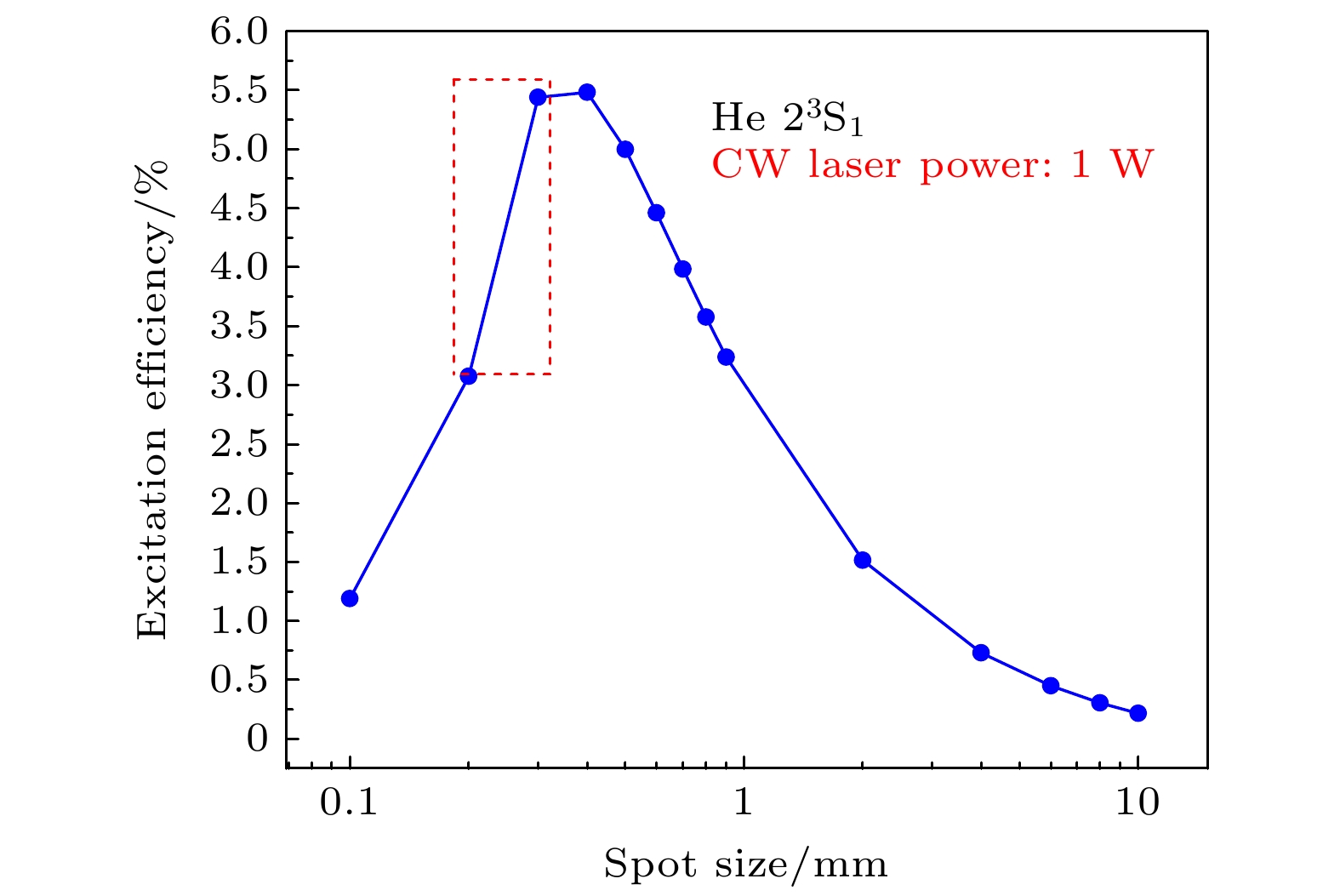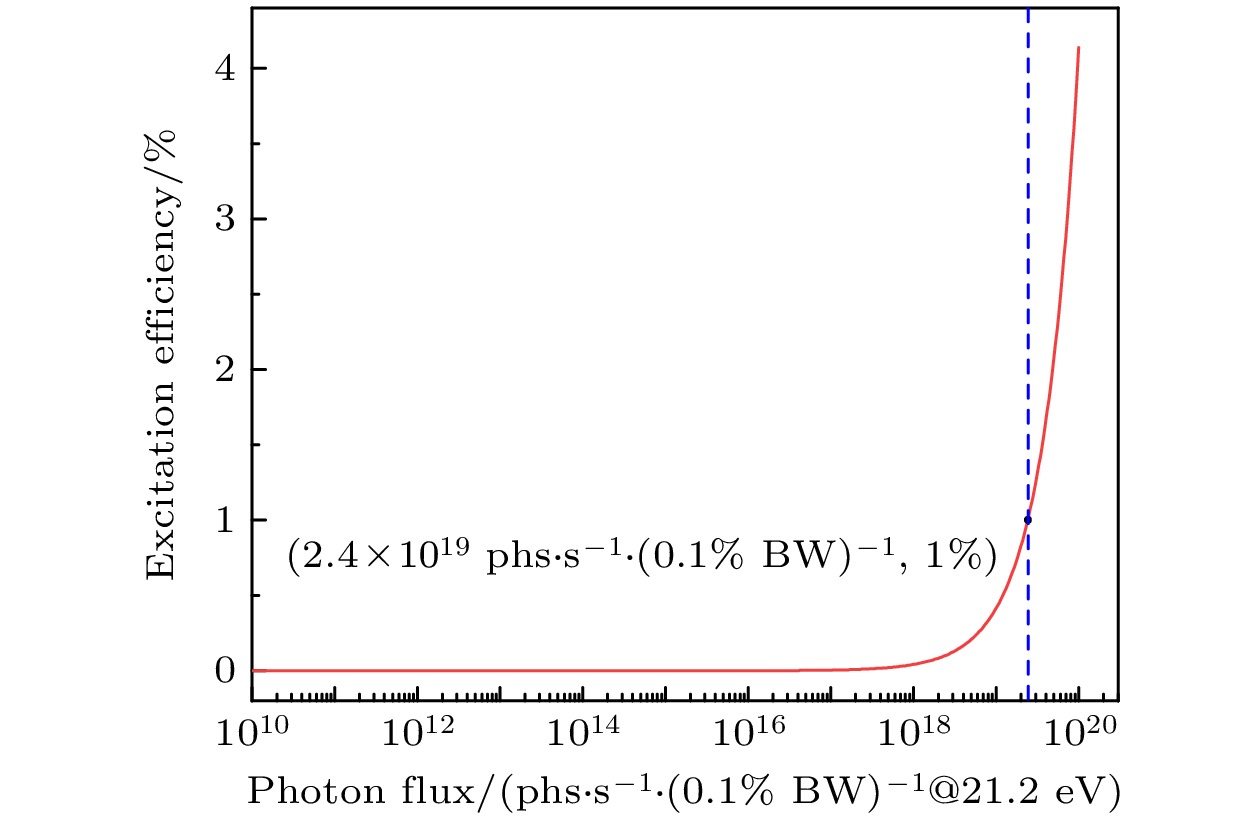-
在少电子原子精密光谱测量中, 产生高强度、单一量子态的氦原子和类氦离子是实验研究的关键, 也是改善实验测量信噪比的决定性因素. 本文提出利用自由电子激光获得高强度亚稳态氦原子和类氦离子的实验方案. 激光的制备效率可以通过求解光和原子相互作用的主方程获得, 根据拟建设的深圳自由电子激光装置的设计参数和实验条件, 计算得到亚稳态He, Li+和Be2+的制备效率分别可达3%, 6%和2%以上. 与常见的气体放电和电子轰击等制备方法相比, 激光激发产生亚稳态原子/离子不仅可以提高制备产率, 也可以降低放电时产生的电子、离子以及光子等高能杂散粒子的影响. 利用自由电子激光激发制备亚稳态氦原子和类氦离子有望应用于多个研究领域.
-
关键词:
- 亚稳态氦原子和类氦离子 /
- 精密光谱 /
- 自由电子激光 /
- 测量信噪比 /
- 制备效率
In the precision spectroscopy of few-electron atoms, the generation of high-intensity metastable helium atoms and helium-like ions is crucial for implementing experimental studies as well as a critical factor for improving the signal-to-noise ratio of experimental measurements. With the rapid development of free-electron laser (FEL) and technology, FEL wavelengths extend from hard X-rays to soft X-rays and even vacuum ultraviolet bands. Meanwhile, laser pulses with ultra-fast, ultra-intense and high repetition frequencies are realized, thus making it possible for FEL to prepare single-quantum state atoms/ions with high efficiency. In this work, we propose an experimental method for obtaining high-intensity single-quantum state helium atoms and helium-like ions by using FEL. The preparation efficiency can be calculated by solving the master equation of light-atom interaction. Considering the experimental parameters involved in this work, we predict that the efficiencies of preparing metastable 23S He, Li+ and Be2+ are about 3%, 6% and 2%, respectively. Compared with the common preparation methods such as gas discharge and electron bombardment, a state-of-the-art laser excitation method can not only increase the preparation efficiency, but also reduce the effects of high-energy stray particles such as electrons, ions, and photons generated during discharge. Furthermore, combined with the laser preparation technique, the sophisticated ion confinement technique, which can ensure a long interaction time between the ions and laser, increases the efficiency of metastable Li+ and Be2+ by several orders of magnitude. Therefore, the preparation of high-intensity metastable helium and helium-like ions can improve the measurement accuracy of precision spectroscopy of atoms and ions. A new experimental method, based on FEL, to study the fine structure energy levels 23P of helium, has the potential to obtain the results with an accuracy exceeding the sub-kHz level. Thus, the high-precision fine structure constants can be determined with the development of high-order quantum electrodynamics theory. In order to measure energy levels with higher accuracy, a new detection technique, which can reduce or even avoid more systematic effects, must be developed. For example, the quantum interference effect, which has been proposed in recent years, seriously affects the accuracy of fine-structure energy levels. If the interference phenomenon of spontaneous radiation between different excited states can be avoided in the detection process, the measurement accuracy will not be affected by this quantum interference effect. High-intensity metastable atoms or ions in chemical reaction dynamics studies also have better chances to investigate reaction mechanisms. In summary, the FEL preparation of high-intensity metastable helium atoms and helium-like ions proposed in this work will lay an important foundation for developing cold atom physics and chemical reaction dynamics.-
Keywords:
- metastable helium and helium-like ions /
- precision spectroscopy /
- free electron laser /
- signal-to-noise ratio /
- preparation effciency
[1] Heydarizadmotlagh F, Skinner T D G, Kato K, George M C, Hessels E A 2024 Phys. Rev. Lett. 132 163001
 Google Scholar
Google Scholar
[2] Wen J L, Tang J D, Dong J F, Du X J, Hu S M, Sun Y R 2023 Phys. Rev. A 107 042811
 Google Scholar
Google Scholar
[3] Henson B, Ross J, Thomas K, et al. 2022 Science 376 199
 Google Scholar
Google Scholar
[4] Tiesinga E, Mohr P J, Newell D B, Taylor B N 2021 J. Phys. Chem. Ref. Data 50 033105
 Google Scholar
Google Scholar
[5] Sun Y R, Hu S M 2020 Natl. Sci. Rev. 7 1818
 Google Scholar
Google Scholar
[6] Chen J J, Sun Y, Wen J L, Hu S M 2020 Phys. Rev. A 101 053824
 Google Scholar
Google Scholar
[7] Kato K, Skinner T, Hessels E 2018 Phys. Rev. Lett. 121 143002
 Google Scholar
Google Scholar
[8] 郑昕, 孙羽, 陈娇娇, 胡水明 2018 物理学报 67 164203
 Google Scholar
Google Scholar
Zheng X, Sun Y R, Chen J J, Hu S M 2018 Acta Phys. Sin. 67 164203
 Google Scholar
Google Scholar
[9] Zheng X, Sun Y, Chen J J, Jiang W, Pachucki K, Hu S M 2017 Phys. Rev. Lett. 119 263002
 Google Scholar
Google Scholar
[10] Feng G P, Zheng X, Sun Y R, Hu S M 2015 Phys. Rev. A 91 030502
 Google Scholar
Google Scholar
[11] Zheng X, Sun Y, Chen J J, Jiang W, Pachucki K, Hu S M 2017 Phys. Rev. Lett. 118 063001
 Google Scholar
Google Scholar
[12] Vutha A C, Hessels E A 2015 Phys. Rev. A 92 052504
 Google Scholar
Google Scholar
[13] Pastor P C, Consolino L, Giusfredi G, De Natale P, Inguscio M, Yerokhin V, Pachucki K 2012 Phys. Rev. Lett. 108 143001
 Google Scholar
Google Scholar
[14] Smiciklas M, Shiner D 2010 Phys. Rev. Lett. 105 123001
 Google Scholar
Google Scholar
[15] Borbely J, George M, Lombardi L, Weel M, Fitzakerley D, Hessels E 2009 Phys. Rev. A 79 060503
 Google Scholar
Google Scholar
[16] Giusfredi G, Pastor P C, Natale P D, Mazzotti D, Mauro C d, Fallani L, Hagel G, Krachmalnicoff V, Inguscio M 2005 Can. J. Phys. 83 301
 Google Scholar
Google Scholar
[17] Zelevinsky T, Farkas D, Gabrielse G 2005 Phys. Rev. Lett. 95 203001
 Google Scholar
Google Scholar
[18] George M, Lombardi L, Hessels E 2001 Phys. Rev. Lett. 87 173002
 Google Scholar
Google Scholar
[19] Sun W, Zhang P P, Zhou P P, Chen S L, Zhou Z Q, Huang Y, Qi X Q, Yan Z C, Shi T Y, Drake G W F, Zhong Z X, Guan H, Gao K L 2023 Phys. Rev. Lett. 131 103002
 Google Scholar
Google Scholar
[20] Scholl T J, Cameron R, Rosner S D, Zhang L, Holt R A, Sansonetti C J, Gillaspy J D 1993 Phys. Rev. Lett. 71 2188
 Google Scholar
Google Scholar
[21] Schwartz C 1964 Phys. Rev. 134 A1181
 Google Scholar
Google Scholar
[22] Paliwal P, Deb N, Reich D M, van der Avoird A, Koch C P, Narevicius E 2021 Nat. Chem. 13 94
 Google Scholar
Google Scholar
[23] Klein A, Shagam Y, Skomorowski W, Zuchowski P S, Pawlak M, Janssen L M, Moiseyev N, Meerakker S Y V D, Avoird A V D, Koch C P, Narevicius E 2017 Nat. Phys. 13 35
 Google Scholar
Google Scholar
[24] Henson A B, Gersten S, Shagam Y, Narevicius J, Narevicius E 2012 Science 338 234
 Google Scholar
Google Scholar
[25] Martin D W, Weiser C, Sperlein R F, Bernfeld D L, Siska P E 1989 J. Chem. Phys 90 1564
 Google Scholar
Google Scholar
[26] Pachucki K, Yerokhin V A 2023 Phys. Rev. Lett. 130 053002
 Google Scholar
Google Scholar
[27] Yerokhin V A, Patkóš V, Pachucki K 2023 Phys. Rev. A 107 012810
 Google Scholar
Google Scholar
[28] Patkóš V, Yerokhin V A, Pachucki K 2021 Phys. Rev. A 103 042809
 Google Scholar
Google Scholar
[29] Pachucki K, Yerokhin V A 2010 Phys. Rev. Lett. 104 070403
 Google Scholar
Google Scholar
[30] Pachucki K, Patkóš V C V, Yerokhin V A 2023 Phys. Rev. A 108 052802
 Google Scholar
Google Scholar
[31] Yerokhin V A, Patkóš V, Pachucki K 2022 Phys. Rev. A 106 022815
 Google Scholar
Google Scholar
[32] Pachucki K 2022 Phys. Rev. A 106 022802
 Google Scholar
Google Scholar
[33] Qi X Q, Zhang P P, Yan Z C, Shi T Y, Drake G W F, Chen A X, Zhong Z X 2023 Phys. Rev. A 107 L010802
 Google Scholar
Google Scholar
[34] Qi X Q, Zhang P P, Yan Z C, Drake G W F, Zhong Z X, Shi T Y, Chen S L, Huang Y, Guan H, Gao K L 2020 Phys. Rev. Lett. 125 183002
 Google Scholar
Google Scholar
[35] Johnson W R, Cheng K T, Plante D R 1997 Phys. Rev. A 55 2728
 Google Scholar
Google Scholar
[36] Tang K T, Toennies J P 1984 J. Chem. Phys. 80 3726
 Google Scholar
Google Scholar
[37] Cheng C F, Jiang W, Yang G M, Sun Y R, Pan H, Gao Y, Liu A W, Hu S M 2010 Rev. Sci. Instrum. 81 123106
 Google Scholar
Google Scholar
[38] Kponou A, Hughes V W, Johnson C E, Lewis S A, Pichanick F M J 1981 Phys. Rev. A 24 264
 Google Scholar
Google Scholar
[39] Scholl T J, Holt R A, Rosner S D 1989 Phys. Rev. A 39 1163
 Google Scholar
Google Scholar
[40] Chen S L, Liang S Y, Sun W, Huang Y, Guan H, Gao K L 2019 Rev. Sci. Instrum. 90 043112
 Google Scholar
Google Scholar
[41] Bergeson S D, Balakrishnan A, Baldwin K, Lucatorto T B, Marangos J, McIlrath T, O’Brian T R, Rolston S, Sansonetti C J, Wen J 1998 Phys. Rev. Lett. 80 3475
 Google Scholar
Google Scholar
[42] Wang J S, Ritterbusch F, Dong X Z, Gao C, Li H, Jiang W, Liu S Y, Lu Z T, Wang W H, Yang G M, Zhang Y S, Zhang Z Y 2021 Phys. Rev. Lett. 127 023201
 Google Scholar
Google Scholar
[43] Steck D A 2017 Quantum and Atom Optics (Eugene: University of Oregon
[44] Baig M 2022 Atoms 10 39
 Google Scholar
Google Scholar
[45] Chen S L, Zhou P P, Liang S Y, Sun W, Sun H Y, Huang Y, Guan H, Gao K L 2020 Chin. Phys. Lett. 37 073201
 Google Scholar
Google Scholar
-
-
[1] Heydarizadmotlagh F, Skinner T D G, Kato K, George M C, Hessels E A 2024 Phys. Rev. Lett. 132 163001
 Google Scholar
Google Scholar
[2] Wen J L, Tang J D, Dong J F, Du X J, Hu S M, Sun Y R 2023 Phys. Rev. A 107 042811
 Google Scholar
Google Scholar
[3] Henson B, Ross J, Thomas K, et al. 2022 Science 376 199
 Google Scholar
Google Scholar
[4] Tiesinga E, Mohr P J, Newell D B, Taylor B N 2021 J. Phys. Chem. Ref. Data 50 033105
 Google Scholar
Google Scholar
[5] Sun Y R, Hu S M 2020 Natl. Sci. Rev. 7 1818
 Google Scholar
Google Scholar
[6] Chen J J, Sun Y, Wen J L, Hu S M 2020 Phys. Rev. A 101 053824
 Google Scholar
Google Scholar
[7] Kato K, Skinner T, Hessels E 2018 Phys. Rev. Lett. 121 143002
 Google Scholar
Google Scholar
[8] 郑昕, 孙羽, 陈娇娇, 胡水明 2018 物理学报 67 164203
 Google Scholar
Google Scholar
Zheng X, Sun Y R, Chen J J, Hu S M 2018 Acta Phys. Sin. 67 164203
 Google Scholar
Google Scholar
[9] Zheng X, Sun Y, Chen J J, Jiang W, Pachucki K, Hu S M 2017 Phys. Rev. Lett. 119 263002
 Google Scholar
Google Scholar
[10] Feng G P, Zheng X, Sun Y R, Hu S M 2015 Phys. Rev. A 91 030502
 Google Scholar
Google Scholar
[11] Zheng X, Sun Y, Chen J J, Jiang W, Pachucki K, Hu S M 2017 Phys. Rev. Lett. 118 063001
 Google Scholar
Google Scholar
[12] Vutha A C, Hessels E A 2015 Phys. Rev. A 92 052504
 Google Scholar
Google Scholar
[13] Pastor P C, Consolino L, Giusfredi G, De Natale P, Inguscio M, Yerokhin V, Pachucki K 2012 Phys. Rev. Lett. 108 143001
 Google Scholar
Google Scholar
[14] Smiciklas M, Shiner D 2010 Phys. Rev. Lett. 105 123001
 Google Scholar
Google Scholar
[15] Borbely J, George M, Lombardi L, Weel M, Fitzakerley D, Hessels E 2009 Phys. Rev. A 79 060503
 Google Scholar
Google Scholar
[16] Giusfredi G, Pastor P C, Natale P D, Mazzotti D, Mauro C d, Fallani L, Hagel G, Krachmalnicoff V, Inguscio M 2005 Can. J. Phys. 83 301
 Google Scholar
Google Scholar
[17] Zelevinsky T, Farkas D, Gabrielse G 2005 Phys. Rev. Lett. 95 203001
 Google Scholar
Google Scholar
[18] George M, Lombardi L, Hessels E 2001 Phys. Rev. Lett. 87 173002
 Google Scholar
Google Scholar
[19] Sun W, Zhang P P, Zhou P P, Chen S L, Zhou Z Q, Huang Y, Qi X Q, Yan Z C, Shi T Y, Drake G W F, Zhong Z X, Guan H, Gao K L 2023 Phys. Rev. Lett. 131 103002
 Google Scholar
Google Scholar
[20] Scholl T J, Cameron R, Rosner S D, Zhang L, Holt R A, Sansonetti C J, Gillaspy J D 1993 Phys. Rev. Lett. 71 2188
 Google Scholar
Google Scholar
[21] Schwartz C 1964 Phys. Rev. 134 A1181
 Google Scholar
Google Scholar
[22] Paliwal P, Deb N, Reich D M, van der Avoird A, Koch C P, Narevicius E 2021 Nat. Chem. 13 94
 Google Scholar
Google Scholar
[23] Klein A, Shagam Y, Skomorowski W, Zuchowski P S, Pawlak M, Janssen L M, Moiseyev N, Meerakker S Y V D, Avoird A V D, Koch C P, Narevicius E 2017 Nat. Phys. 13 35
 Google Scholar
Google Scholar
[24] Henson A B, Gersten S, Shagam Y, Narevicius J, Narevicius E 2012 Science 338 234
 Google Scholar
Google Scholar
[25] Martin D W, Weiser C, Sperlein R F, Bernfeld D L, Siska P E 1989 J. Chem. Phys 90 1564
 Google Scholar
Google Scholar
[26] Pachucki K, Yerokhin V A 2023 Phys. Rev. Lett. 130 053002
 Google Scholar
Google Scholar
[27] Yerokhin V A, Patkóš V, Pachucki K 2023 Phys. Rev. A 107 012810
 Google Scholar
Google Scholar
[28] Patkóš V, Yerokhin V A, Pachucki K 2021 Phys. Rev. A 103 042809
 Google Scholar
Google Scholar
[29] Pachucki K, Yerokhin V A 2010 Phys. Rev. Lett. 104 070403
 Google Scholar
Google Scholar
[30] Pachucki K, Patkóš V C V, Yerokhin V A 2023 Phys. Rev. A 108 052802
 Google Scholar
Google Scholar
[31] Yerokhin V A, Patkóš V, Pachucki K 2022 Phys. Rev. A 106 022815
 Google Scholar
Google Scholar
[32] Pachucki K 2022 Phys. Rev. A 106 022802
 Google Scholar
Google Scholar
[33] Qi X Q, Zhang P P, Yan Z C, Shi T Y, Drake G W F, Chen A X, Zhong Z X 2023 Phys. Rev. A 107 L010802
 Google Scholar
Google Scholar
[34] Qi X Q, Zhang P P, Yan Z C, Drake G W F, Zhong Z X, Shi T Y, Chen S L, Huang Y, Guan H, Gao K L 2020 Phys. Rev. Lett. 125 183002
 Google Scholar
Google Scholar
[35] Johnson W R, Cheng K T, Plante D R 1997 Phys. Rev. A 55 2728
 Google Scholar
Google Scholar
[36] Tang K T, Toennies J P 1984 J. Chem. Phys. 80 3726
 Google Scholar
Google Scholar
[37] Cheng C F, Jiang W, Yang G M, Sun Y R, Pan H, Gao Y, Liu A W, Hu S M 2010 Rev. Sci. Instrum. 81 123106
 Google Scholar
Google Scholar
[38] Kponou A, Hughes V W, Johnson C E, Lewis S A, Pichanick F M J 1981 Phys. Rev. A 24 264
 Google Scholar
Google Scholar
[39] Scholl T J, Holt R A, Rosner S D 1989 Phys. Rev. A 39 1163
 Google Scholar
Google Scholar
[40] Chen S L, Liang S Y, Sun W, Huang Y, Guan H, Gao K L 2019 Rev. Sci. Instrum. 90 043112
 Google Scholar
Google Scholar
[41] Bergeson S D, Balakrishnan A, Baldwin K, Lucatorto T B, Marangos J, McIlrath T, O’Brian T R, Rolston S, Sansonetti C J, Wen J 1998 Phys. Rev. Lett. 80 3475
 Google Scholar
Google Scholar
[42] Wang J S, Ritterbusch F, Dong X Z, Gao C, Li H, Jiang W, Liu S Y, Lu Z T, Wang W H, Yang G M, Zhang Y S, Zhang Z Y 2021 Phys. Rev. Lett. 127 023201
 Google Scholar
Google Scholar
[43] Steck D A 2017 Quantum and Atom Optics (Eugene: University of Oregon
[44] Baig M 2022 Atoms 10 39
 Google Scholar
Google Scholar
[45] Chen S L, Zhou P P, Liang S Y, Sun W, Sun H Y, Huang Y, Guan H, Gao K L 2020 Chin. Phys. Lett. 37 073201
 Google Scholar
Google Scholar
计量
- 文章访问数: 6038
- PDF下载量: 218
- 被引次数: 0















 下载:
下载:




